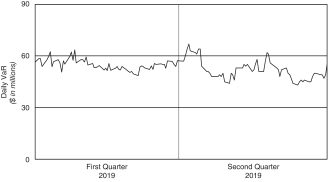THE GOLDMAN SACHS GROUP, INC. AND SUBSIDIARIES
Notes to Consolidated Financial Statements
On December 17, 2018, the Attorney General of Malaysia filed criminal charges in Malaysia against Goldman Sachs International (GSI), as the arranger of three offerings of debt securities of 1MDB, aggregating approximately $6.5 billion in principal amount, for alleged disclosure deficiencies in the offering documents relating to, among other things, the use of proceeds for the debt securities, as well as against Goldman Sachs (Asia) LLC (GS Asia) and Goldman Sachs (Singapore) PTE (GS Singapore). Criminal charges have also been filed against Leissner, Low, Ng and Jasmine Loo Ai Swan. In a related press release, the Attorney General of Malaysia indicated that prosecutors in Malaysia will seek criminal fines against the accused in excess of $2.7 billion plus the $600 million of fees received in connection with the debt offerings.
The Malaysia Securities Commission issued notices to show cause against Goldman Sachs (Malaysia) Sdn Bhd (GS Malaysia) in December 2018 and March 2019 that (i) allege possible violations of Malaysian securities laws and (ii) indicate that the Malaysia Securities Commission is considering whether to revoke GS Malaysia’s license to conduct corporate finance and fund management activities in Malaysia.
The firm has received multiple demands, beginning in November 2018, from alleged shareholders under Section 220 of the Delaware General Corporation Law for books and records relating to, among other things, the firm’s involvement with 1MDB and the firm’s compliance procedures.
On February 19, 2019, a purported shareholder derivative action relating to 1MDB was filed in the U.S. District Court for the Southern District of New York against Group Inc. and the directors at the time and a former chairman and chief executive officer of the firm. The amended complaint filed on July 12, 2019, which seeks unspecified damages, disgorgement and injunctive relief, alleges breaches of fiduciary duties, including in connection with alleged insider trading by certain current and former directors, unjust enrichment and violations of the anti-fraud provisions of the Exchange Act, including in connection with Group Inc.’s common stock repurchases and solicitation of proxies.
Beginning in March 2019, the firm has also received demands from alleged shareholders to investigate and pursue claims against certain current and former directors and executive officers based on their oversight and public disclosures regarding 1MDB and related internal controls.
On November 21, 2018, a summons with notice was filed in New York Supreme Court, New York County, by International Petroleum Investment Company, which guaranteed certain debt securities issued by 1MDB, and its subsidiary Aabar Investments PJS. The summons with notice makes unspecified claims relating to 1MDB and seeks unspecified compensatory and punitive damages and other relief against Group Inc., GSI, GS Asia, GS Singapore, GS Malaysia, Leissner, Ng, and an employee of the firm, as well as individuals (who are not employees of the firm) formerly associated with the plaintiffs.
On December 20, 2018, a putative securities class action lawsuit was filed in the U.S. District Court for the Southern District of New York against Group Inc. and certain current and former officers of the firm alleging violations of the anti-fraud provisions of the Exchange Act with respect to Group Inc.’s disclosures concerning 1MDB and seeking unspecified damages.
The firm is cooperating with the DOJ and all other governmental and regulatory investigations relating to 1MDB and is engaged in discussions with various governmental and regulatory authorities. Proceedings by the DOJ or other governmental or regulatory authorities could result in the imposition of significant fines, penalties and other sanctions against the firm, including restrictions on the firm’s activities.
Beginning in April 2010, a number of purported securities law class actions were filed in the U.S. District Court for the Southern District of New York challenging the adequacy of Group Inc.’s public disclosure of, among other things, the firm’s activities in the collateralized debt obligation market, and the firm’s conflict of interest management.
The consolidated amended complaint filed on July 25, 2011, which names as defendants Group Inc. and certain current and former officers and employees of Group Inc. and its affiliates, generally alleges violations of Sections 10(b) and 20(a) of the Exchange Act and seeks unspecified damages. The defendants have moved for summary judgment. On December 11, 2018, the Second Circuit Court of Appeals granted the defendants’ petition for interlocutory review of the district court’s August 14, 2018 grant of class certification. On January 23, 2019, the district court stayed proceedings in the district court pending the appellate court’s decision.

